
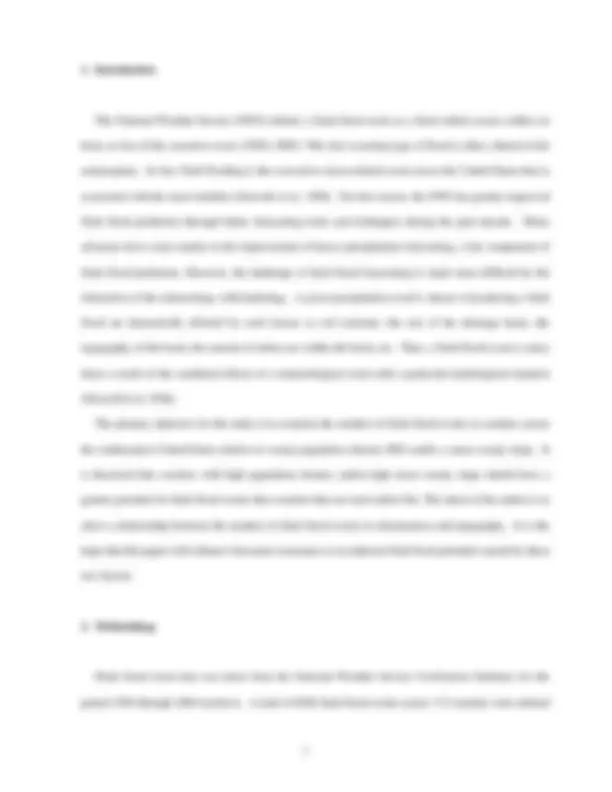

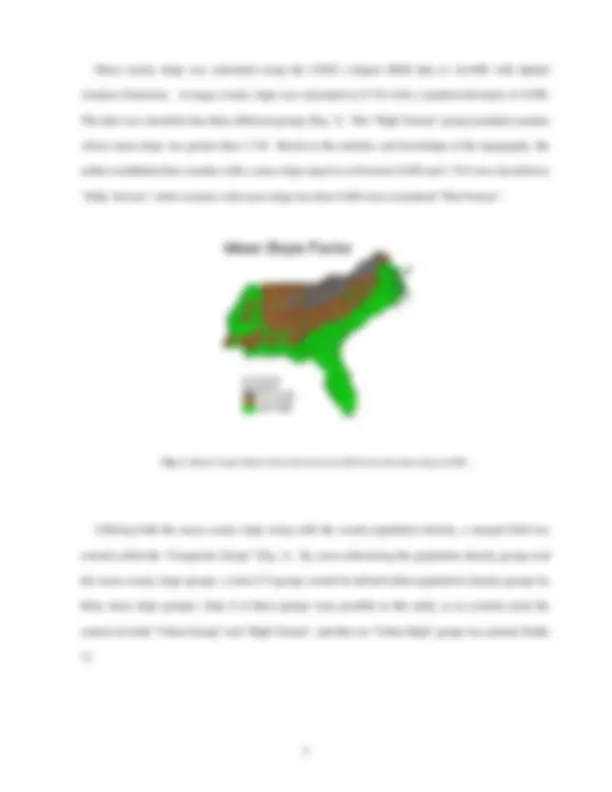
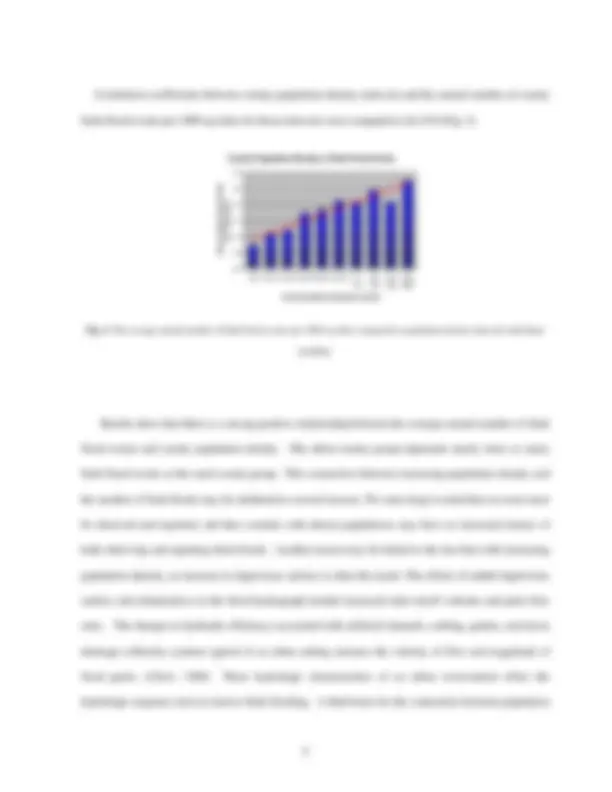
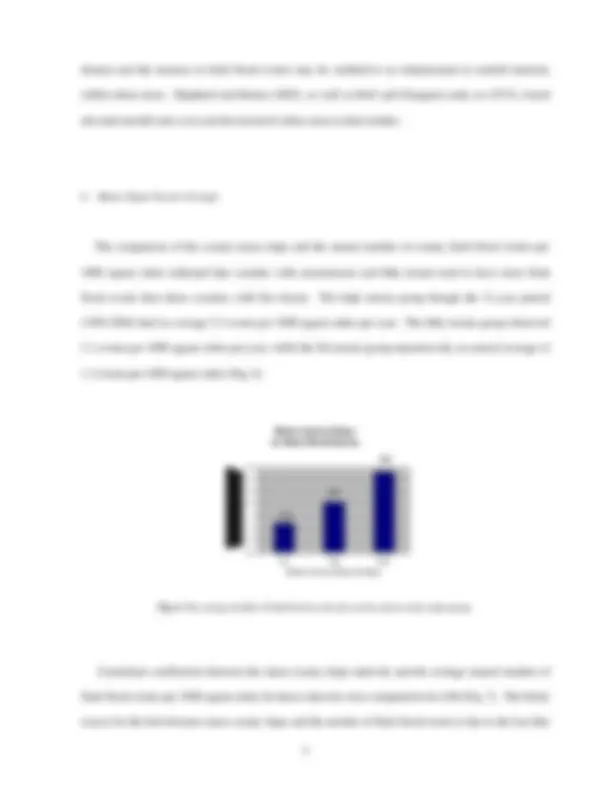
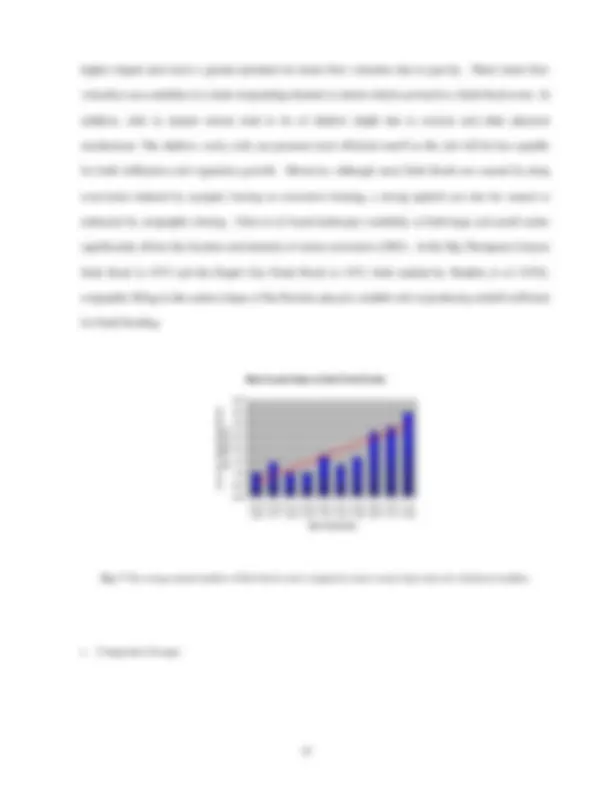
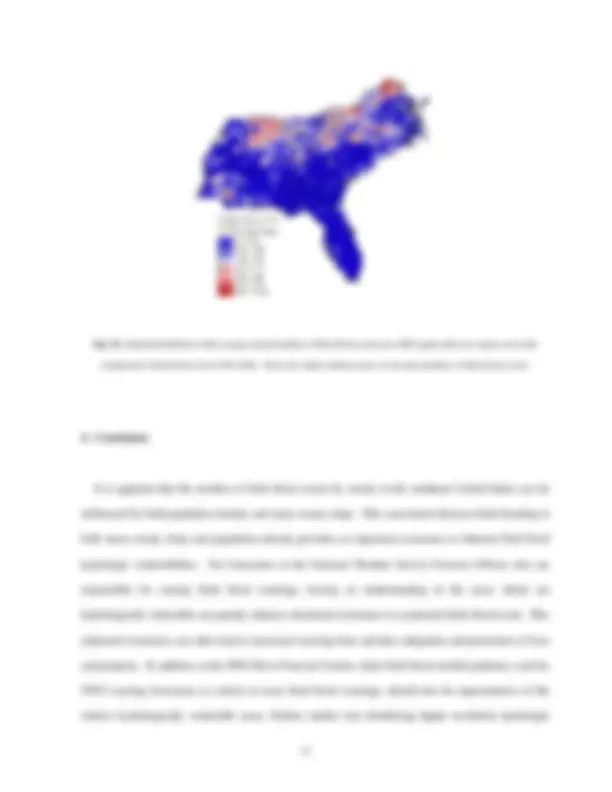




Study with the several resources on Docsity

Earn points by helping other students or get them with a premium plan


Prepare for your exams
Study with the several resources on Docsity

Earn points to download
Earn points by helping other students or get them with a premium plan
Community
Ask the community for help and clear up your study doubts
Discover the best universities in your country according to Docsity users
Free resources
Download our free guides on studying techniques, anxiety management strategies, and thesis advice from Docsity tutors
A study that investigates the relationship between the number of flash flood events in counties across the southeastern United States and both county population density and mean county slope. The results indicate that densely populated areas with hilly to high terrain are the most susceptible to flash flooding, as these areas have a greater potential for flash flood events than rural and/or flat areas.
What you will learn
Typology: Study notes
1 / 15

This page cannot be seen from the preview
Don't miss anything!










Abstract
Flooding contributes to more than 100 deaths each year across the United States with most deaths due to flash flooding. Though most flash floods are caused by intense rainfall, the magnitude of a flash flood is dramatically affected by pre-existing physical factors such as ground cover, topography and soil moisture. This study looks at two of these pre-existing physical factors by examining the relationship between the number of flash flood events within a county to both the county population density and mean county slope. Results showed that with increasing county population density there is an increase in the average annual number of flash flood events. With increasing mean county slope there is also an increase in the average annual number of flash flood events. A composite factor was developed to account for both population density and mean slope together. This factor when compared to the average annual number of flash flood events indicates that densely populated areas within hilly to high terrain are the most susceptible to flash flooding. It is the hope that these results will highlight hydrologically vulnerable areas that are prone to flash flooding in the southeastern United States. With this improved understanding, National Weather Service (NWS) forecaster situational awareness will increase, leading to more accurate and timely flash flood warnings.
in the study covering an eight state area (Alabama, Florida, Georgia, Mississippi, North Carolina, South Carolina, Tennessee, and Virginia) within the southeastern United States. This total area encompassed 374,905 square miles. The number of flash flood events per county was normalized by the county area per 1000 square miles. County population density data was calculated from Environmental Systems Research Institute (ESRI) Geographic Information Systems (ESRI, 2000) data. To account for variations in county area that may influence the number of events, counties less than 100 square miles were excluded from the analysis which consisted of 36 municipality counties in Virginia. Slope data was calculated using ESRI Arc/Info Geographic Information Systems utilizing USGS 1-degree Digital Elevation Map (DEM) data. Counties were grouped into three groups for analysis (Fig. 1). Average population density for the dataset was 138 people per square mile with a standard deviation of 255. Thus the author established that the “Urban” county group included all counties whose population density exceeded 393 people per square mile. The “Suburban” county group included all counties whose population density was equal to or between 138 to 393 people per square mile, while the “Rural” county group included all counties with population density less than 138 people per square mile.
Fig. 1. Population Density Groups utilizing 1999 Census data provided through ESRI Arcview.
Mean county slope was calculated using the USGS 1-degree DEM data in ArcGIS with Spatial Analysis Extension. Average county slope was calculated at 0.754 with a standard deviation of 0.990. The data was classified into three different groups (Fig. 2). The “High Terrain” group included counties whose mean slope was greater than 1.744. Based on the statistics and knowledge of the topography, the author established that counties with a mean slope equal to or between 0.400 and 1.744 were classified as “Hilly Terrain”, while counties with mean slope less than 0.400 were considered “Flat Terrain”.
Fig. 2. Mean County Slope Factor derived from USGS elevation data using ArcGIS.
Utilizing both the mean county slope along with the county population density, a merged field was created called the “Composite Group” (Fig. 3). By cross-referencing the population density groups and the mean county slope groups, a total of 9 groups would be defined (three population density groups by three mean slope groups). Only 8 of these groups were possible in this study as no counties meet the criteria for both “Urban Group” and “High Terrain”, and thus no “Urban-High” group was created (Table 1).
comparing the relationship between the average annual number of flash flood events per 1000 square miles and the three groups were also calculated. The intervals depicted within the correlation analysis were computed by using every tenth percentile within each of the three groups to provide for an even breakdown in the groups for comparison to flash flood events. To further support the analysis of the relationship between flash flood events to both slope and population density, the number of county flash flood events per 1000 square miles will be shown geographically providing a comparison to known urban and high slope areas in the southeastern United States.
3. Results
a. Population Density Groups
When comparing flash flood events against county population density groups, data showed that the urban county group had the highest density of flash flood events with an average of 3.0 flash flood events per 1000 square miles per year through the 11-year period. The suburban county group observed 2. events per 1000 square miles per year with the rural county group at 1.6 events per 1000 square miles per year (Fig. 4).
County Population Densityvs Flash Flood Events
2.3 3. 1.
0.00.
1.01.
2.02.
3.03.
Rural Po p ulat io n D ensit y Gr o up s Suburban Urban
Fig. 4. The annual number of flash flood events per 1000 sq miles by population density group.
Correlation coefficients between county population density intervals and the annual number of county flash flood events per 1000 sq miles for those intervals were computed to be 0.94 (Fig. 5).
County Population Density vs Flash Flood Events
0-22 23-31 32-39 40-49 50-60 60-78 104 79- 105- 162 163- 293 2867 294- County Population Density (per sq mile)
A nnual Fla sh Flood Ev ent
s
per 100 0 sq m i
Fig. 5. The average annual number of flash flood events per 1000 sq miles compared to population density intervals with linear trendline.
Results show that there is a strong positive relationship between the average annual number of flash flood events and county population density. The urban county group represents nearly twice as many flash flood events as the rural county group. This connection between increasing population density and the number of flash floods may be attributed to several reasons. We must keep in mind that an event must be observed and reported, and thus counties with denser populations may have an increased chance of both observing and reporting flash floods. Another reason may be linked to the fact that with increasing population density, an increase in impervious surface is often the result. The effects of added impervious surface and urbanization on the flood hydrograph include increased total runoff volumes and peak flow rates. The changes in hydraulic efficiency associated with artificial channels, curbing, gutters, and storm drainage collection systems typical of an urban setting increase the velocity of flow and magnitude of flood peaks. (Chow, 1988) These hydrologic characteristics of an urban environment affect the hydrologic response and can lead to flash flooding. A third basis for the connection between population
higher sloped areas have a greater potential for faster flow velocities due to gravity. These faster flow velocities can contribute to a faster responding channel or stream which can lead to a flash flood event. In addition, soils in steeper terrain tend to be of shallow depth due to erosion and other physical mechanisms. The shallow, rocky soils can promote more efficient runoff as the soil will be less capable for both infiltration and vegetation growth. Moreover, although most flash floods are caused by deep convection induced by synoptic forcing or convective heating, a strong updraft can also be caused or enhanced by orographic forcing. Chen et al found landscape variability at both large and small scales significantly affects the location and intensity of moist convection (2001). In the Big Thompson Canyon flash flood in 1975 and the Rapid City Flash Flood in 1972, both studied by Maddox et al (1978), orographic lifting in the eastern slopes of the Rockies played a notable role in producing rainfall sufficient for flash flooding.
Mean County Slope vs Flash Flood Events
0.000.
1.001.
2.002.
3.003.
0.00-0.090.09-0.160.16-0.280.28-0.360.36-0.430.43-0.490.49-0.590.59-0.920.92-2.132.13-5. Mean County Slope
A v er. A nn. Flash Flood Event
s
pe r 100 0 s q m i
Fig. 7. The average annual number of flash flood events compared to mean county slope intervals with linear trendline.
c. Composite Groups
Comparison of the “Composite Groups” to flash flood events showed that the “Suburban-High” group observed the most flash flood events with an average annual 4.7 flash flood events per 1000 square miles. The “Rural-Flat” group observed the least number of events with an average of 0.9 flash flood events per 1000 square miles annually (Fig. 8).
Population Density-Mean County SlopeComposite vs Flash Flood Events
0.9 1.^
1.8 2.5^ 2.
3.1 3.
4.
0.00.
1.01.
2.02.
3.03.
4.04.
Rural-FlatSuburban-FlatRural-HillySuburban-HillyUrban-FlatRural-HighUrban-HillySuburban-High Population Density-Mean County Slope CompositeGroups
Ave. Ann. Flash Flood Events
per 1000 sq mi
Fig. 8. The average number of flash flood events per year by the population density-mean county slope composite groups.
In examining the correlations between the “Composite Groups” and flash flood events, population density and mean county slope were normalized to the corresponding average value. These two normalized values were then multiplied together to calculate a “Composite Group” factor. The “Composite Group” factor was then used to determine correlations between the composite group and the number of flash flood events. In comparing the every tenth percentile intervals of the “Composite Group” factor and the average annual number of flash flood events per 1000 square miles, correlations coefficients were 0.95, indicating a strong positive relationship (Fig. 9). More importantly, the correlation between the merged factors and the number of flash flood events is slightly greater than the correlation when comparing county population density or mean county slope alone.
Fig. 10. Spatial distribution of the average annual number of flash flood events per 1000 square miles by county across the southeastern United States from 1994-2004. Red color shades indicate areas of elevated numbers of flash flood events.
4. Conclusion
It is apparent that the number of flash flood events by county in the southeast United States can be influenced by both population density and mean county slope. This association between flash flooding to both mean county slope and population density provides an important awareness to inherent flash flood hydrologic vulnerabilities. For forecasters at the National Weather Service Forecast Offices who are responsible for issuing flash flood warnings, having an understanding of the areas which are hydrologically vulnerable can greatly enhance situational awareness to a potential flash flood event. This enhanced awareness can often lead to increased warning time and thus mitigation and protection of lives and property. In addition, at the NWS River Forecast Centers, daily flash flood rainfall guidance, used by NWS warning forecasters as criteria to issue flash flood warnings, should also be representative of the relative hydrologically vulnerable areas. Further studies into identifying higher resolution hydrologic
vulnerable areas would provide even greater awareness, and could be incorporated into NWS warning programs such as the Flash Flood Monitoring Program, or FFMP.
Acknowledgements
The author would like to thank Reggina Cabrera from the National Weather Service Southeast River Forecast Center (SERFC) for her extensive review of this paper, Mark Love from SERFC for his guidance on obtaining mean slope data, and Wylie Quillian, John Feldt and Brad Gimmestad from SERFC and James Noel of the National Weather Service Ohio River Forecast Center (OHRFC) for their suggestions on improvements.
Author
Jeff Dobur currently serves as a Senior Hydrologist at the National Weather Service Southeast River Forecast Center (SERFC) in Peachtree City, Georgia. Prior to this, he has served as a Hydrologic Analysis and Support Meteorologist at SERFC, a Public and Aviation Forecaster at the NWSFO Peachtree City, GA, a Hydrologist with the Ohio River Forecast Center (OHRFC) and a Meteorologist at the NWSFO in Wilmington, Ohio, in addition to working as an Assistant to the State Climatologist in Ohio. His educational background includes a BS in Atmospheric Sciences from the Ohio State University (1997) and additional graduate course work in Hydrology/Civil Engineering from the University of Cincinnati.